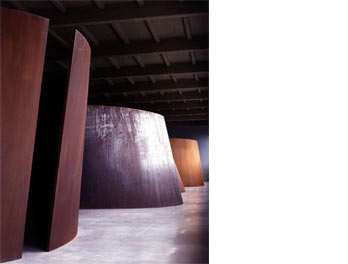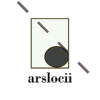 Having visited Dia:Beacon several times, (and it isn’t nearby) I am continually surprised by what I find there. The space is overwhelming, with huge, cavernous rooms and hallways, all in giant scale; the light is ethereal, whether delivered indirectly through the clerestory windows, or directly through window walls where some of the glass is textured in a fractured opacity and just their clear central panes allow outdoors glimpses and sunlight to penetrate the monastic ambiance. And, too, the visual array of artworks (because that is the point, right?), from Robert Ryman’s all-white canvases to Richard Serra’s monoliths of hard and rusting steel, tempt you in every conceivable way with sui generis sensuousness and mystery.
Having visited Dia:Beacon several times, (and it isn’t nearby) I am continually surprised by what I find there. The space is overwhelming, with huge, cavernous rooms and hallways, all in giant scale; the light is ethereal, whether delivered indirectly through the clerestory windows, or directly through window walls where some of the glass is textured in a fractured opacity and just their clear central panes allow outdoors glimpses and sunlight to penetrate the monastic ambiance. And, too, the visual array of artworks (because that is the point, right?), from Robert Ryman’s all-white canvases to Richard Serra’s monoliths of hard and rusting steel, tempt you in every conceivable way with sui generis sensuousness and mystery.
But, as all these other senses are fully engaged, so fully that at times you want to cry or fall to your knees or just feel the vibration and disappear into the energy that each piece and each space is emitting, suddenly, this visit, there is the realization that one sense that had been formerly neglected I am now experiencing – smell. Olfaction. Yes, smelling art.
When I was in art school I smelled art everywhere. Every classroom and, later, every studio had a smell – a particular smell: oil paint, clay, acrylic paint, printmaking ink, sawdust, welding fumes. Largely, these were toxic smells of chemical reactions, but to anyone who spent time breathing them they were the smells of creativity. The smells are so universal and have become such a part of the fabric of art-making that I can walk into any artist’s studio and smell the familiar, immediately bouncing me back to a connected past with my school days. This is generally not the case in the more staid museums; everything is so controlled, often encased, air-quality adjusted and purified.
But, at Dia, I was noticing olfactory changes as I drifted from room to room, artist to artist, material to material. I became excited by this added layer of experiencing the works and the spaces they occupy. Often the inner, windowless rooms there have a stillness with an odor that accompanies the unmoving air. As I became more acclimated to the smells, I realized that each artwork had its own individual smell and that, when clustered in groups, or when massive enough to stand alone, there was a very noticeable odor associated with the galleries they inhabited and imparted to them. At first it was a vague awareness of changes in the air, then I started to home in on trying to “explain” or dissect what it was I was inhaling. I became acutely aware in Imi Knoebel’s Raum 19, a construction of wooden shapes and paint stretchers with that sweet, old lumber fragrance. Something you would smell in a bone-dry attic, with hints of Masonite and fir emanating from old pieces of furniture.
With Agnes Martin, one would expect the smell of both linseed oil and acrylics, of course, but here they were faint, light, clear and pale – just like her canvases; whereas Robert Ryman’s works, whether room-size or small scale, had the presence of all smells. And On Kawara’s Today Series, daily paintings from 1966 to 2000, had an indistinct smell, a blurring of the years. Dan Flavin’s fluorescent tubes had the whiff of heated dust combined with an electronic or solder pungency. While Joseph Beuys’ stacks of felt had, what else – wool, reminiscent of a formerly wet dog now dried, dust coatings and aged socks or mittens. Donald Judd’s Untitled (1976), was, as expected, plywood scented but almost minty in its intensity. And when the setting sun blasted through the clerestory above the minimal box constructions and the oils in the wood heated up, it was like a plywood sawmill without the dust, in the permeating aroma.
And so, I wondered, what about Richard Serra, could his pieces possibly have a fragrance? His monoliths of steel, a material that would seem almost inert except for oxidation: slabs of some natural mineral ores blended into a manufactured structural product? What smell could they possibly have? Hey, though, remember the plywood of Judd. (And right here I must confess to Serra being a favorite, so I really wanted the giant pieces to smell like something.) Union of the Torus and the Sphere sits in a kind of hallway and as close as I allowed my nose to scan it, there was, disappointingly, just a hint of something, at spots, a mild rust smell. I hurried downstairs to the Torqued Ellipses, his wonderful massive herd of shapes which you enter, are labyrinthine and so meditative that you get dizzy inside them. I took a deep breath; inhaled a dry cave, desiccated even. I smelled the rust, stronger now because I was inside the steel chamber and the enclosed air was more concentrated. There were distinct chalk-like odors, hints of dry mold as in cheese. Ah, yes, a fine blend, so fine I wanted to drink it in.
And once again I find placeness: in smell. It is said that smell is the most vivid sense memory. I hope to be sniffing Serra for many years to come.


